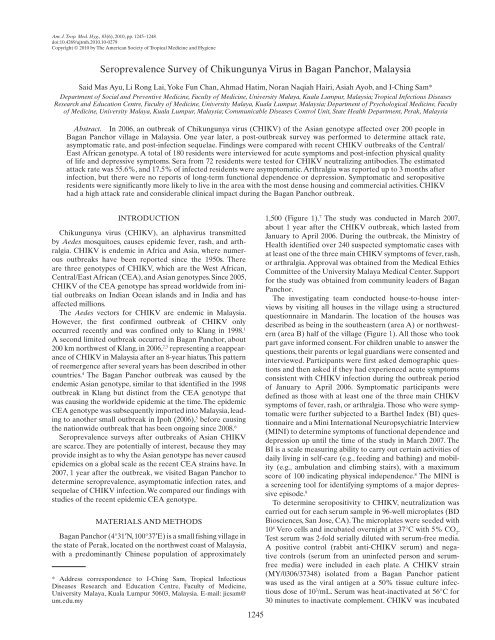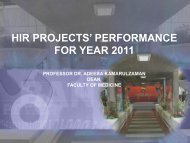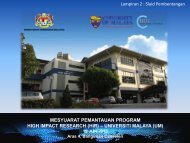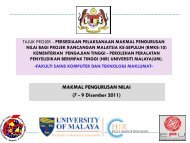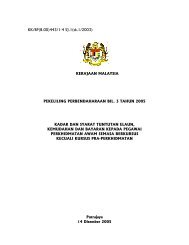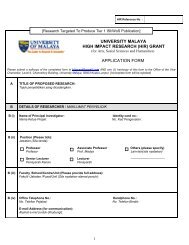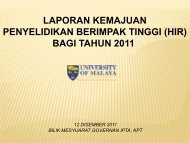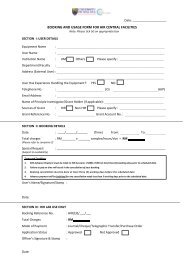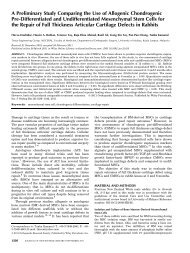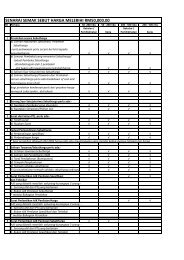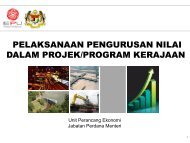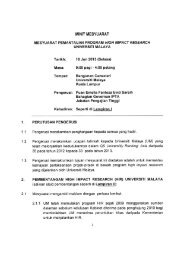Seroprevalence Survey of Chikungunya Virus in Bagan Panchor ...
Seroprevalence Survey of Chikungunya Virus in Bagan Panchor ...
Seroprevalence Survey of Chikungunya Virus in Bagan Panchor ...
You also want an ePaper? Increase the reach of your titles
YUMPU automatically turns print PDFs into web optimized ePapers that Google loves.
Am. J. Trop. Med. Hyg., 83(6), 2010, pp. 1245–1248doi:10.4269/ajtmh.2010.10-0279Copyright © 2010 by The American Society <strong>of</strong> Tropical Medic<strong>in</strong>e and Hygiene<strong>Seroprevalence</strong> <strong>Survey</strong> <strong>of</strong> <strong>Chikungunya</strong> <strong>Virus</strong> <strong>in</strong> <strong>Bagan</strong> <strong>Panchor</strong>, MalaysiaSaid Mas Ayu , Li Rong Lai , Yoke Fun Chan , Ahmad Hatim , Noran Naqiah Hairi , Asiah Ayob , and I-Ch<strong>in</strong>g Sam *Department <strong>of</strong> Social and Preventive Medic<strong>in</strong>e, Faculty <strong>of</strong> Medic<strong>in</strong>e, University Malaya, Kuala Lumpur, Malaysia; Tropical Infectious DiseasesResearch and Education Centre, Faculty <strong>of</strong> Medic<strong>in</strong>e, University Malaya, Kuala Lumpur, Malaysia; Department <strong>of</strong> Psychological Medic<strong>in</strong>e, Faculty<strong>of</strong> Medic<strong>in</strong>e, University Malaya, Kuala Lumpur, Malaysia; Communicable Diseases Control Unit, State Health Department, Perak, MalaysiaAbstract. In 2006, an outbreak <strong>of</strong> <strong>Chikungunya</strong> virus (CHIKV) <strong>of</strong> the Asian genotype affected over 200 people <strong>in</strong><strong>Bagan</strong> <strong>Panchor</strong> village <strong>in</strong> Malaysia. One year later, a post-outbreak survey was performed to determ<strong>in</strong>e attack rate,asymptomatic rate, and post-<strong>in</strong>fection sequelae. F<strong>in</strong>d<strong>in</strong>gs were compared with recent CHIKV outbreaks <strong>of</strong> the Central/East African genotype. A total <strong>of</strong> 180 residents were <strong>in</strong>terviewed for acute symptoms and post-<strong>in</strong>fection physical quality<strong>of</strong> life and depressive symptoms. Sera from 72 residents were tested for CHIKV neutraliz<strong>in</strong>g antibodies. The estimatedattack rate was 55.6%, and 17.5% <strong>of</strong> <strong>in</strong>fected residents were asymptomatic. Arthralgia was reported up to 3 months after<strong>in</strong>fection, but there were no reports <strong>of</strong> long-term functional dependence or depression. Symptomatic and seropositiveresidents were significantly more likely to live <strong>in</strong> the area with the most dense hous<strong>in</strong>g and commercial activities. CHIKVhad a high attack rate and considerable cl<strong>in</strong>ical impact dur<strong>in</strong>g the <strong>Bagan</strong> <strong>Panchor</strong> outbreak.INTRODUCTION<strong>Chikungunya</strong> virus (CHIKV), an alphavirus transmittedby Aedes mosquitoes, causes epidemic fever, rash, and arthralgia.CHIKV is endemic <strong>in</strong> Africa and Asia, where numerousoutbreaks have been reported s<strong>in</strong>ce the 1950s. Thereare three genotypes <strong>of</strong> CHIKV, which are the West African,Central/East African (CEA), and Asian genotypes. S<strong>in</strong>ce 2005,CHIKV <strong>of</strong> the CEA genotype has spread worldwide from <strong>in</strong>itialoutbreaks on Indian Ocean islands and <strong>in</strong> India and hasaffected millions.The Aedes vectors for CHIKV are endemic <strong>in</strong> Malaysia.However, the first confirmed outbreak <strong>of</strong> CHIKV onlyoccurred recently and was conf<strong>in</strong>ed only to Klang <strong>in</strong> 1998. 1A second limited outbreak occurred <strong>in</strong> <strong>Bagan</strong> <strong>Panchor</strong>, about200 km northwest <strong>of</strong> Klang, <strong>in</strong> 2006, 2, 3 represent<strong>in</strong>g a reappearance<strong>of</strong> CHIKV <strong>in</strong> Malaysia after an 8-year hiatus. This pattern<strong>of</strong> reemergence after several years has been described <strong>in</strong> othercountries. 4 The <strong>Bagan</strong> <strong>Panchor</strong> outbreak was caused by theendemic Asian genotype, similar to that identified <strong>in</strong> the 1998outbreak <strong>in</strong> Klang but dist<strong>in</strong>ct from the CEA genotype thatwas caus<strong>in</strong>g the worldwide epidemic at the time. The epidemicCEA genotype was subsequently imported <strong>in</strong>to Malaysia, lead<strong>in</strong>gto another small outbreak <strong>in</strong> Ipoh (2006), 5 before caus<strong>in</strong>gthe nationwide outbreak that has been ongo<strong>in</strong>g s<strong>in</strong>ce 2008. 6<strong>Seroprevalence</strong> surveys after outbreaks <strong>of</strong> Asian CHIKVare scarce. They are potentially <strong>of</strong> <strong>in</strong>terest, because they mayprovide <strong>in</strong>sight as to why the Asian genotype has never causedepidemics on a global scale as the recent CEA stra<strong>in</strong>s have. In2007, 1 year after the outbreak, we visited <strong>Bagan</strong> <strong>Panchor</strong> todeterm<strong>in</strong>e seroprevalence, asymptomatic <strong>in</strong>fection rates, andsequelae <strong>of</strong> CHIKV <strong>in</strong>fection. We compared our f<strong>in</strong>d<strong>in</strong>gs withstudies <strong>of</strong> the recent epidemic CEA genotype.MATERIALS AND METHODS<strong>Bagan</strong> <strong>Panchor</strong> (4°31′N, 100°37′E) is a small fish<strong>in</strong>g village <strong>in</strong>the state <strong>of</strong> Perak, located on the northwest coast <strong>of</strong> Malaysia,with a predom<strong>in</strong>antly Ch<strong>in</strong>ese population <strong>of</strong> approximately* Address correspondence to I-Ch<strong>in</strong>g Sam, Tropical InfectiousDiseases Research and Education Centre, Faculty <strong>of</strong> Medic<strong>in</strong>e,University Malaya, Kuala Lumpur 50603, Malaysia. E-mail: jicsam@um.edu.my12451,500 ( Figure 1 ). 7 The study was conducted <strong>in</strong> March 2007,about 1 year after the CHIKV outbreak, which lasted fromJanuary to April 2006. Dur<strong>in</strong>g the outbreak, the M<strong>in</strong>istry <strong>of</strong>Health identified over 240 suspected symptomatic cases withat least one <strong>of</strong> the three ma<strong>in</strong> CHIKV symptoms <strong>of</strong> fever, rash,or arthralgia. Approval was obta<strong>in</strong>ed from the Medical EthicsCommittee <strong>of</strong> the University Malaya Medical Center. Supportfor the study was obta<strong>in</strong>ed from community leaders <strong>of</strong> <strong>Bagan</strong><strong>Panchor</strong>.The <strong>in</strong>vestigat<strong>in</strong>g team conducted house-to-house <strong>in</strong>terviewsby visit<strong>in</strong>g all houses <strong>in</strong> the village us<strong>in</strong>g a structuredquestionnaire <strong>in</strong> Mandar<strong>in</strong>. The location <strong>of</strong> the houses wasdescribed as be<strong>in</strong>g <strong>in</strong> the southeastern (area A) or northwestern(area B) half <strong>of</strong> the village ( Figure 1 ). All those who tookpart gave <strong>in</strong>formed consent. For children unable to answer thequestions, their parents or legal guardians were consented and<strong>in</strong>terviewed. Participants were first asked demographic questionsand then asked if they had experienced acute symptomsconsistent with CHIKV <strong>in</strong>fection dur<strong>in</strong>g the outbreak period<strong>of</strong> January to April 2006. Symptomatic participants weredef<strong>in</strong>ed as those with at least one <strong>of</strong> the three ma<strong>in</strong> CHIKVsymptoms <strong>of</strong> fever, rash, or arthralgia. Those who were symptomaticwere further subjected to a Barthel Index (BI) questionnaireand a M<strong>in</strong>i International Neuropsychiatric Interview(MINI) to determ<strong>in</strong>e symptoms <strong>of</strong> functional dependence anddepression up until the time <strong>of</strong> the study <strong>in</strong> March 2007. TheBI is a scale measur<strong>in</strong>g ability to carry out certa<strong>in</strong> activities <strong>of</strong>daily liv<strong>in</strong>g <strong>in</strong> self-care (e.g., feed<strong>in</strong>g and bath<strong>in</strong>g) and mobility(e.g., ambulation and climb<strong>in</strong>g stairs), with a maximumscore <strong>of</strong> 100 <strong>in</strong>dicat<strong>in</strong>g physical <strong>in</strong>dependence. 8 The MINI isa screen<strong>in</strong>g tool for identify<strong>in</strong>g symptoms <strong>of</strong> a major depressiveepisode. 9To determ<strong>in</strong>e seropositivity to CHIKV, neutralization wascarried out for each serum sample <strong>in</strong> 96-well microplates (BDBiosciences, San Jose, CA). The microplates were seeded with10 4 Vero cells and <strong>in</strong>cubated overnight at 37°C with 5% CO 2.Test serum was 2-fold serially diluted with serum-free media.A positive control (rabbit anti-CHIKV serum) and negativecontrols (serum from an un<strong>in</strong>fected person and serumfreemedia) were <strong>in</strong>cluded <strong>in</strong> each plate. A CHIKV stra<strong>in</strong>(MY/0306/37348) isolated from a <strong>Bagan</strong> <strong>Panchor</strong> patientwas used as the viral antigen at a 50% tissue culture <strong>in</strong>fectiousdose <strong>of</strong> 10 3 /mL. Serum was heat-<strong>in</strong>activated at 56°C for30 m<strong>in</strong>utes to <strong>in</strong>activate complement. CHIKV was <strong>in</strong>cubated
1246 MAS AYU AND OTHERSFigure 1. Representation <strong>of</strong> <strong>Bagan</strong> <strong>Panchor</strong> village, which isarranged along a 1-km road runn<strong>in</strong>g from southeast to northwest adjacentto the <strong>Panchor</strong> River as it flows <strong>in</strong>to the Straits <strong>of</strong> Malacca. Thevillage is surrounded by a mangrove forest. The residences <strong>of</strong> seropositiveand seronegative residents with<strong>in</strong> areas A and B are shown.Seropositive cases were more likely to reside with<strong>in</strong> area B, which isalso where the shops and restaurants are located.with an equal volume <strong>of</strong> serum at 37°C for 1 hour. This antigen–serummixture was then added to the Vero cells <strong>in</strong> themicroplate and shaken for 1 hour. Excess suspension wasremoved, cells were briefly washed with serum-free media,and Eagle’s M<strong>in</strong>imum Essential Medium with 2% fetal bov<strong>in</strong>eserum (Thermo Fisher Scientific, Waltham, MA) was addedfor ma<strong>in</strong>tenance. The cells <strong>in</strong> the microplate were observedfor characteristic cytopathic effect. The neutralization titerfor a given serum sample was determ<strong>in</strong>ed by the highestdilution at which that serum neutralized the virus at day 7.Serum that conta<strong>in</strong>ed no neutraliz<strong>in</strong>g activity did not <strong>in</strong>hibitcytopathic effects and was considered to be seronegative.Serum with neutraliz<strong>in</strong>g activity was considered to be seropositive,<strong>in</strong>dicat<strong>in</strong>g laboratory-confirmed past CHIKV <strong>in</strong>fection.Each serum sample was tested <strong>in</strong> triplicate.Data were analyzed us<strong>in</strong>g SPSS 15.0 (SPSS Inc., Chicago,IL). Descriptive analysis was performed on demographic andsymptoms data. For univariate analysis, Mann-Whitney U testswere used for cont<strong>in</strong>uous variables, and χ 2 or Fisher’s exacttests were used for categorical variables. Logistic regressionanalyses were also carried out to determ<strong>in</strong>e demographic predictors<strong>of</strong> two separate outcomes: symptomatic disease andCHIKV seropositivity. Univariate logistic regression was <strong>in</strong>itiallycarried out for each variable. Those significant at P < 0.2were entered <strong>in</strong>to the multivariate regression model based onthe likelihood ratio test. F<strong>in</strong>al P values <strong>of</strong> < 0.05 were consideredas significant.RESULTSThere were about 150 houses <strong>in</strong> total <strong>in</strong> the village. A total<strong>of</strong> 180 residents, or 12% <strong>of</strong> the estimated 1,500 people, from80 houses agreed to be <strong>in</strong>terviewed ( Table 1 ) (mean age =38.2 years; range = 1–77 years). The 80 houses where the <strong>in</strong>terviewedparticipants lived were spread throughout the village;there was no difference between the percentages <strong>of</strong> housessampled <strong>in</strong> area A and area B (47.9% versus 58.2%; χ 2 = 1.6,P = 0.21). Of the 180 residents <strong>in</strong>terviewed, 72 (40.0%) agreedto have their serum tested (mean age = 44.0 years; range =12–77 years). Of the 72 people tested, 40 (55.6%) were seropositive,and 7 (17.5%) <strong>of</strong> these were asymptomatic. Of thetested acutely symptomatic participants, 33 <strong>of</strong> 38 (86.8%) wereseropositive; 7 <strong>of</strong> 34 (20.6%) tested asymptomatic participantswere seropositive. Three <strong>of</strong> seven asymptomatic seropositiveresidents had a symptomatic household member.Table 1Demographic characteristics <strong>of</strong> study participantsParticipants <strong>in</strong>terviewedParticipants tested for CHIKVTotal( N = 180)Asymptomatic( N = 109)Symptomatic( N = 71)Univariate analysis( P value)Total( N = 72)Seronegative( N = 32)Seropositive( N = 40)Univariate analysis( P value)Age (years)≤ 18 years 38 26 (68.4%) 12 (31.6%) 0.15 5 3 (60.0%) 2 (40.0%) 0.3219–49 years 79 49 (62.0%) 30 (38.0%) 0.33 39 19 (48.7%) 20 (51.3%) 0.29≥ 50 years 63 34 (54.0%) 29 (46.0%) Reference 28 10 (35.7%) 18 (64.3%) ReferenceSexMale 84 53 (63.1%) 31 (36.9%) Reference 38 20 (52.6%) 18 (47.4%) ReferenceFemale 96 56 (58.3%) 40 (41.7%) 0.52 34 12 (35.3%) 22 (64.7%) 0.14Residential areaA 82 62 (75.6%) 20 (24.4%) Reference 28 17 (60.7%) 11 (39.3%) ReferenceB 98 47 (48.0%) 51 (52.0%) < 0.001 * 44 15 (34.1%) 29 (65.9%) 0.03 †Education ‡Primary 77 43 (55.8%) 34 (44.2%) Reference 39 13 (33.3%) 26 (66.7%) ReferenceSecondary or tertiary 41 26 (63.4%) 15 (36.6%) 0.43 17 9 (52.9%) 8 (47.1%) 0.17Child ≤ 18 years 38 27 (71.1%) 11 (28.9%) 0.12 5 4 (80.0%) 1 (20.0%) 0.08No formal education 23 12 (52.2%) 11 (47.8%) 0.76 10 5 (50.0%) 5 (50.0%) 0.33Occupation ‡Housewife 56 31 (55.4%) 25 (44.6%) Reference 22 8 (36.4%) 14 (63.6%) ReferenceStudent 38 27 (71.1%) 11 (28.9%) 0.13 5 4 (80.0%) 1 (20.0%) 0.11Fisherman 24 13 (54.2%) 11 (45.8%) 0.92 16 7 (43.8%) 9 (56.3%) 0.65Unemployed 14 10 (71.4%) 4 (28.6%) 0.28 8 3 (37.5%) 5 (62.5%) 0.95Bus<strong>in</strong>essman 12 5 (41.7%) 7 (58.3%) 0.70 4 1 (25.0%) 3 (75.0%) 0.44Retired 10 7 (70.0%) 3 (30.0%) 0.39 4 3 (75.0%) 1 (25.0%) 0.66Other 25 15 (60.0%) 10 (40.0%) 0.39 12 6 (50.0%) 6 (50.0%) 0.18* Liv<strong>in</strong>g <strong>in</strong> area B was reta<strong>in</strong>ed <strong>in</strong> the f<strong>in</strong>al regression model as a predictor <strong>of</strong> be<strong>in</strong>g symptomatic (adjusted odds ratio = 3.4; 95% confidence <strong>in</strong>tervals = 1.8–6.4; P < 0.001).† Liv<strong>in</strong>g <strong>in</strong> area B was reta<strong>in</strong>ed <strong>in</strong> the f<strong>in</strong>al regression model as a predictor <strong>of</strong> be<strong>in</strong>g seropositive for CHIKV (adjusted odds ratio = 3.0; 95% confidence <strong>in</strong>tervals = 1.1–7.9; P = 0.029).‡ Data is miss<strong>in</strong>g for one patient.
CHIKUNGUNYA IN BAGAN PANCHOR, MALAYSIA1247Table 2Cl<strong>in</strong>ical features <strong>of</strong> seropositive residents with laboratory-confirmed<strong>Chikungunya</strong> <strong>in</strong>fection ( N = 40)Symptomatic and seropositive cases were reported throughoutthe village, although there were more cases <strong>in</strong> the northwesternhalf by the mouth <strong>of</strong> the river (area B <strong>in</strong> Figure 1 ),which had more dense hous<strong>in</strong>g, the jetty, shops, and restaurants.This was confirmed by multivariate analyses; the only significant<strong>in</strong>dependent demographic predictor <strong>of</strong> both symptomaticdisease and seropositivity was residence <strong>in</strong> area B ( Table 1 ).Other demographics such as age, sex, education background,and occupation were not significant predictors.The cl<strong>in</strong>ical features <strong>of</strong> the 40 seropositive residents areshown <strong>in</strong> Table 2 . Of the 33 symptomatic cases, the most commonsymptoms were arthralgia (90.9%), fever (75.8%), andrash (63.6%). The most frequently affected jo<strong>in</strong>ts were knees,ankles, elbows, and wrists. Of the 30 seropositive cases report<strong>in</strong>garthralgia, 29 stated that jo<strong>in</strong>t symptoms lasted for amedian <strong>of</strong> 14 days (range = 2–100 days).Two (5.0%) seropositive people reported dependence onothers for self-care activities such as us<strong>in</strong>g the toilet and dress<strong>in</strong>g,and one <strong>of</strong> two people required a wheelchair. This dependencewas temporary, last<strong>in</strong>g between 3 and 30 days. Only one<strong>of</strong> the seropositive residents, who had arthralgia symptoms for100 days, reported concurrent depressive symptoms <strong>of</strong> loss <strong>of</strong><strong>in</strong>terest and tiredness; this was <strong>in</strong>sufficient to meet the criteriafor a major depressive episode.DISCUSSIONNumber/total %Asymptomatic 7/40 17.5Symptomatic 33/40 82.5Arthralgia 30/33 90.9Knees 22/30 73.3Ankles 20/30 66.7Elbows 20/30 66.7Wrists 15/30 50.0F<strong>in</strong>gers 12/30 40.0Shoulders 6/30 20.0Sp<strong>in</strong>e 2/30 6.7Fever 25/33 75.8Rash 21/33 63.6Myalgia 16/33 48.5Headache 10/33 30.3Pruritus 8/33 24.2Nausea 1/33 3.0Bleed<strong>in</strong>g 0/33 0This study is the first seroprevalence study to be performed<strong>in</strong> Malaysia s<strong>in</strong>ce the 1960s, when “a very low level <strong>of</strong> populationimmunity” was found <strong>in</strong> the western states, <strong>in</strong>clud<strong>in</strong>gPerak. 10 A total <strong>of</strong> 72 <strong>Bagan</strong> <strong>Panchor</strong> residents were tested,which is higher than the 63 tested dur<strong>in</strong>g the outbreak. 2, 3Compared with the contemporary Indian Ocean outbreaks,the attack rate <strong>in</strong> <strong>Bagan</strong> <strong>Panchor</strong> <strong>of</strong> 55.6% was higher thanthe rates <strong>in</strong> Mayotte 11 and Réunion Island 12 but lower than therates <strong>in</strong> the Comoros 13 and Lamu Island <strong>in</strong> Kenya 14 ( Table 3 ).The <strong>Bagan</strong> <strong>Panchor</strong> rate may overestimate the true attack rate,because symptomatic participants were more likely to agreeto test<strong>in</strong>g than the asymptomatic participants (53.5% versus31.2%; χ 2 = 8.9, P = 0.003). Differences <strong>in</strong> attack rates arelikely caused by local factors, <strong>in</strong>clud<strong>in</strong>g population immunityand genetic susceptibility, vector competence, environmentalsett<strong>in</strong>gs, and effectiveness <strong>of</strong> outbreak control measures.These may also vary with<strong>in</strong> the same locality. We found thatresidence <strong>in</strong> the northwestern half <strong>of</strong> the village, where thema<strong>in</strong> commercial activities and a greater density <strong>of</strong> hous<strong>in</strong>gwere located, predicted symptomatic disease and seropositivity.We did not explicitly study the reasons for this <strong>in</strong> <strong>Bagan</strong><strong>Panchor</strong>, but it is likely that social and environmental factorscontributed. For example, <strong>in</strong> Mayotte, CHIKV seroprevalencewas higher <strong>in</strong> households with structural risk factors for mosquitobreed<strong>in</strong>g or exposure, such as open yards and outdoortoilets. 17 In two neighborhoods <strong>in</strong> Rio de Janeiro, the highestseroprevalence <strong>of</strong> dengue was seen <strong>in</strong> the busiest areas, whereshops, schools, and transport hubs were located. 18The asymptomatic rate <strong>of</strong> 17.5% <strong>in</strong> our sample is with<strong>in</strong> therange <strong>of</strong> 16.7–27.8% reported <strong>in</strong> other studies. 11,12,15,16 This rateis much lower than that <strong>of</strong> dengue, which has asymptomaticrates <strong>of</strong> over 70%. 18, 19 In the present study, 33 <strong>of</strong> 38 (86.8%)symptomatic participants were seropositive, similar to the 53<strong>of</strong> 63 (84.1%) symptomatic cases with laboratory-confirmedCHIKV <strong>in</strong>fection reported dur<strong>in</strong>g the outbreak. 2, 3 Some <strong>of</strong>the suspected cases could be caused by other <strong>in</strong>fections giv<strong>in</strong>gsimilar cl<strong>in</strong>ical symptoms, such as dengue. Symptom-basedsurveillance is, therefore, not enough to accurately determ<strong>in</strong>ethe attack rate dur<strong>in</strong>g CHIKV outbreaks, and asymptomaticpeople must also be tested. Asymptomatic cases wouldhave played a role <strong>in</strong> community transmission, because theywould not be conf<strong>in</strong>ed to their homes like ill cases and wouldrema<strong>in</strong> mobile and active dur<strong>in</strong>g their viremic stage.The acute symptoms reported <strong>in</strong> this study were similar toother outbreaks. Long-term sequelae, especially arthralgia,have been reported <strong>in</strong> uncontrolled studies. 20 However, theonly study to date us<strong>in</strong>g matched controls found that CHIKV<strong>in</strong>fectedpatients had only slightly reduced physical scoresfor quality <strong>of</strong> life, with no impact on medical care received ormental scores. 21 In support <strong>of</strong> this, we found no residual physicaldependence or depression <strong>in</strong> our sample. This supports theTable 3Laboratory-confirmed attack rates and symptomatic:asymptomatic case ratios reported <strong>in</strong> previous CHIKV outbreaksSite (year <strong>of</strong> outbreak) CHIKV genotype *Estimatedpopulation sizeSample size testedfor CHIKV (%) Attack rate (%)Asymptomaticrate (%)Symptomatic:asymptomatic ratioReference<strong>Bagan</strong> <strong>Panchor</strong>, Malaysia (2006) Asian 1,500 72 (4.8) 55.6 17.5 4.7 This studyCastiglione di Cervia, Italy (2007) CEA 2,000 325 (16.3) 10.2 17.9 4.6 15Mayotte (2006) CEA 175,000 1,154 (0.7) 37.2 27.8 2.6 11Réunion Island (2005–2006) CEA 787,836 2,442 (0.3) 38.2 16.7 5.0 12Grande Comore, Comoros (2005) CEA 340,000 331 (0.9) 63 – – 13Lamu Island, Kenya (2004) CEA 18,000 288 (1.6) 75 – – 14Barangay Pulo, Philipp<strong>in</strong>es (1996) Unknown(probably Asian) 500 298 (59.6) 65.5 23.3 3.3 16* CEA = Central/East African.
1248 MAS AYU AND OTHERSneed to better understand long-term outcomes <strong>of</strong> CHIKV<strong>in</strong>fection.There are limitations <strong>of</strong> our study. Over one-half <strong>of</strong> the participantswere housewives and children < 18 years, those mostlikely to be at home dur<strong>in</strong>g the daytime when the study wasconducted. However, there were no significant differences <strong>in</strong>symptomatic disease or seropositivity among the differentoccupations. Because the study was carried out 1 year after theoutbreak, there is the potential <strong>of</strong> recall bias. F<strong>in</strong>ally, we cannotexclude the possibility that asymptomatic seropositive residentswere actually <strong>in</strong>fected before or after the outbreak. However, allthe symptomatic residents reported symptoms only dur<strong>in</strong>g theoutbreak, and because CHIKV <strong>in</strong>fection is mostly symptomatic,this suggests that the disease was active only at that time.In summary, the outbreak <strong>of</strong> Asian CHIKV <strong>in</strong> <strong>Bagan</strong><strong>Panchor</strong> was comparable with recent outbreaks <strong>of</strong> the epidemicCEA genotype <strong>in</strong> terms <strong>of</strong> acute symptoms, attackrate, and asymptomatic <strong>in</strong>fection rate. The high attack rateand the duration <strong>of</strong> arthralgia for as long as 3 months showthe impact <strong>of</strong> a CHIKV outbreak on a susceptible population.<strong>Seroprevalence</strong> was greater <strong>in</strong> the part <strong>of</strong> the villagewith more human activity, which suggests that busy communalareas should be specifically targeted with vector control measuresdur<strong>in</strong>g an outbreak.Received May 17, 2010. Accepted for publication September 28, 2010.Acknowledgments: We acknowledge the k<strong>in</strong>d cooperation <strong>of</strong> the residents<strong>of</strong> <strong>Bagan</strong> <strong>Panchor</strong> dur<strong>in</strong>g this study. The authors thank Nord<strong>in</strong>Mohamed, Norizan Moez, the Master <strong>of</strong> Public Health students,and the medical students who were part <strong>of</strong> the <strong>in</strong>vestigation team.F<strong>in</strong>ancial support: This study was funded by the Ch<strong>in</strong>a Medical Boardand University Malaya (High Impact Research Grant AllocationJ-73565).Authors’ addresses: Said Mas Ayu and Noran Naqiah Hairi,Department <strong>of</strong> Social and Preventive Medic<strong>in</strong>e, Faculty <strong>of</strong> Medic<strong>in</strong>e,University Malaya, Kuala Lumpur, Malaysia, E-mails: mas_ayu@um.edu.my and noran@um.edu.my . Li Rong Lai, Yoke Fun Chan, andI-Ch<strong>in</strong>g Sam, Tropical Infectious Diseases Research and EducationCentre, Faculty <strong>of</strong> Medic<strong>in</strong>e, University Malaya, Kuala Lumpur,Malaysia, E-mails: amylaibeloved@hotmail.com , chanyf@um.edu.my ,and jicsam@um.edu.my . Ahmad Hatim, Department <strong>of</strong> PsychologicalMedic<strong>in</strong>e, Faculty <strong>of</strong> Medic<strong>in</strong>e, University Malaya, Kuala Lumpur,Malaysia, E-mail: hatim@um.edu.my . Asiah Ayob, CommunicableDiseases Control Unit, State Health Department, Ipoh, Perak,Malaysia, E-mail: drasiahayob@moh.gov.my .REFERENCES1. Lam SK , Chua KB , Hooi PS , Rahimah MA , Kumari S ,Tharmaratnam M , Chuah SK , Smith DW , Sampson IA , 2001 .<strong>Chikungunya</strong> <strong>in</strong>fection—an emerg<strong>in</strong>g disease <strong>in</strong> Malaysia .Southeast Asian J Trop Med Public Health 32: 447 – 451 .2. AbuBakar S , Sam IC , Wong PF , MatRahim N , Hooi PS , Roslan N ,2007 . Reemergence <strong>of</strong> endemic <strong>Chikungunya</strong>, Malaysia . EmergInfect Dis 13: 147 – 149 .3. Kumarasamy V , Prathapa S , Zuridah H , Chem YK , Norizah I ,Chua KB , 2006 . Re-emergence <strong>of</strong> <strong>Chikungunya</strong> virus <strong>in</strong>Malaysia . Med J Malaysia 61: 221 – 225 .4. Pavri K , 1986 . Disappearance <strong>of</strong> <strong>Chikungunya</strong> virus from Indiaand Southeast Asia . Trans R Soc Trop Med Hyg 80: 491 .5. Noridah O , Paranthaman V , Nayar SK , Masliza M , Ranjit K ,Norizah I , Chem YK , Mustafa B , Kumarasamy V , Chua KB ,2007 . Outbreak <strong>of</strong> <strong>Chikungunya</strong> due to virus <strong>of</strong> Central/EastAfrican genotype <strong>in</strong> Malaysia . Med J Malaysia 62: 323 – 328 .6. Sam IC , Chan YF , Chan SY , Loong SK , Ch<strong>in</strong> HK , Hooi PS , GaneswrieR , AbuBakar S , 2009 . <strong>Chikungunya</strong> virus <strong>of</strong> Asian and Central/East African genotypes <strong>in</strong> Malaysia . J Cl<strong>in</strong> Virol 46: 180 –183 .7. Google Maps , 2010 . <strong>Bagan</strong> <strong>Panchor</strong> Dalam . Available at : http://maps.google.com/maps?q=4.533+100.633+(<strong>Bagan</strong>+panchor+dalam)&ll=4.533,100.633&spn=05.0,05.0&t=k&hl=en . AccessedJuly 31, 2010 .8. Mahoney FI , Barthel DW , 1965 . Functional evaluation: the Barthel<strong>in</strong>dex . Md State Med J 14: 61 – 65 .9. Sheehan DV , Lecrubier Y , Sheehan KH , Amorim P , Janavs J , WeillerE , Hergueta T , Baker R , Dunbar GC , 1998 . The M<strong>in</strong>i-InternationalNeuropsychiatric Interview (M.I.N.I.): the development and validation<strong>of</strong> a structured diagnostic psychiatric <strong>in</strong>terview forDSM-IV and ICD-10 . J Cl<strong>in</strong> Psychiatry 59 (Suppl 20) : 22 –33 .10. Marchette NJ , Rudnick A , Garcia R , 1980 . Alphaviruses <strong>in</strong> pen<strong>in</strong>sularMalaysia. II. Serological evidence <strong>of</strong> human <strong>in</strong>fection .Southeast Asian J Trop Med Public Health 11: 14 – 23 .11. Sissoko D , Moendandze A , Malvy D , Giry C , Ezzed<strong>in</strong>e K , Solet JL ,Pierre V , 2008 . <strong>Seroprevalence</strong> and risk factors <strong>of</strong> <strong>Chikungunya</strong>virus <strong>in</strong>fection <strong>in</strong> Mayotte, Indian Ocean, 2005–2006: a population-basedsurvey . PLoS One 3: e3066 .12. Gérard<strong>in</strong> P , Guernier V , Perrau J , Fianu A , Le Roux K , Grivard P ,Michault A , de Lamballerie X , Flahault A , Favier F , 2008 .Estimat<strong>in</strong>g <strong>Chikungunya</strong> prevalence <strong>in</strong> La Réunion Island outbreakby serosurveys: two methods for two critical times <strong>of</strong> theepidemic . BMC Infect Dis 8: 99 .13. Sergon K , Yahaya AA , Brown J , Bedja SA , Ml<strong>in</strong>dasse M , Agata N ,Allaranger Y , Ball MD , Powers AM , Ofula V , Onyango C ,Konongoi LS , Sang R , Njenga MK , Breiman RF , 2007 .<strong>Seroprevalence</strong> <strong>of</strong> <strong>Chikungunya</strong> virus <strong>in</strong>fection on GrandeComore Island, Union <strong>of</strong> the Comoros, 2005 . Am J Trop MedHyg 76: 1189 – 1193 .14. Sergon K , Njuguna C , Kalani R , Ofula V , Onyango C , KonongoiLS , Bedno S , Burke H , Dumilla AM , Konde J , Njgenga MK ,Sang R , Breiman RF , 2008 . <strong>Seroprevalence</strong> <strong>of</strong> <strong>Chikungunya</strong>virus (CHIKV) <strong>in</strong>fection on Lamu Island, Kenya, October 2004 .Am J Trop Med Hyg 78: 333 – 337 .15. Moro ML , Gagliotti C , Silvi G , Angel<strong>in</strong>i R , Sambri V , Rezza G ,Massimiliani E , Mattivi A , Grilli E , F<strong>in</strong>arelli AC , Spataro N ,Pierro AM , Seyler T , Mac<strong>in</strong>i P , <strong>Chikungunya</strong> Study Group, 2010 .<strong>Chikungunya</strong> virus <strong>in</strong> north-eastern Italy: a seroprevalencestudy . Am J Trop Med Hyg 82: 508 – 511 .16. Retuya TJA Jr , T<strong>in</strong>g DL , Dacula BD , Lanada JM , Roque VG Jr ,Hugo CT , Ogayon JG , Abad-Viola GB , Roces MCR , 1998 .<strong>Chikungunya</strong> fever outbreak <strong>in</strong> an agricultural village <strong>in</strong> Indang,Cavite, Philipp<strong>in</strong>es . Philipp J Microbiol Infect Dis 27: 93 –96 .17. Raude J , Setbon M , 2009 . The role <strong>of</strong> environmental and <strong>in</strong>dividualfactors <strong>in</strong> the social epidemiology <strong>of</strong> <strong>Chikungunya</strong> diseaseon Mayotte Island . Health Place 15: 689 – 699 .18. Honório NA , Nogueira RMR , Codeço CT , Carvalho MS , CruzOG , Magalhães MAFM , de Araújo JMG , de Araújo ESM ,Gomes MQ , P<strong>in</strong>heiro LS , da Silva P<strong>in</strong>el C , Lourenço-de-Oliveira R , 2009 . Spatial evaluation and model<strong>in</strong>g <strong>of</strong> dengueseroprevalence and vector density <strong>in</strong> Rio de Janeiro, Brazil .PLoS Negl Trop Dis 3: e545 .19. Porter KR , Beckett CG , Kosasih H , Tan RI , Alisjahbana B ,Rudiman PIF , Widjaja S , Listiyan<strong>in</strong>gsih E , Ma’Roef CN ,McArdle JL , Parwati I , Sudjana P , Jusuf H , Yuwono D , WuryadiS , 2005 . Epidemiology <strong>of</strong> dengue and dengue hemorrhagic fever<strong>in</strong> a cohort <strong>of</strong> adults liv<strong>in</strong>g <strong>in</strong> Bandung, West Java, Indonesia .Am J Trop Med Hyg 72: 60 – 66 .20. Borgher<strong>in</strong>i G , Poubeau P , Jossaume A , Gouix A , Cotte L , MichaultA , Arv<strong>in</strong>-Berod C , Pagan<strong>in</strong> F , 2007 . Persistent arthralgia associatedwith <strong>Chikungunya</strong> virus: a study <strong>of</strong> 88 adult patients onReunion Island . Cl<strong>in</strong> Infect Dis 47: 469 – 475 .21. Souahoro MK , Gérard<strong>in</strong> P , Boëlle PY , Perrau J , Fianu A , PouchotJ , Malvy D , Flahault A , Favier F , Hanslik T , 2009 . Impact <strong>of</strong><strong>Chikungunya</strong> virus <strong>in</strong>fection on health status and quality <strong>of</strong> life:a retrospective cohort study . PLoS One 4: e7800 .


